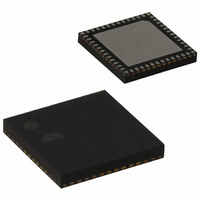EM357-RTR Ember, EM357-RTR Datasheet - Page 30

EM357-RTR
Manufacturer Part Number
EM357-RTR
Description
IC RF TXRX ZIGBEE 192KB 48QFN
Manufacturer
Ember
Specifications of EM357-RTR
Frequency
2.4GHz
Data Rate - Maximum
250kbps
Modulation Or Protocol
802.15.4 Zigbee
Applications
General Purpose
Power - Output
5dBm
Sensitivity
-100dBm
Voltage - Supply
2.1 V ~ 3.6 V
Current - Receiving
26mA
Current - Transmitting
31mA
Data Interface
PCB, Surface Mount
Memory Size
192kB Flash, 12kB RAM
Antenna Connector
PCB, Surface Mount
Operating Temperature
-40°C ~ 85°C
Package / Case
48-QFN
Lead Free Status / RoHS Status
Lead free / RoHS Compliant
Other names
636-1011-2
Available stocks
Company
Part Number
Manufacturer
Quantity
Price
Company:
Part Number:
EM357-RTR
Manufacturer:
SILICON
Quantity:
3 000
Part Number:
EM357-RTR
Manufacturer:
SILICON
Quantity:
20 000
- Current page: 30 of 245
- Download datasheet (12Mb)
4.3
4.4
4.5
4.6
Calibration
Integrated MAC Module
Packet Trace Interface (PTI)
Random Number Generator
nTX_ACTIVE is the alternate function of PC6. See Chapter 7 GPIO for details of the alternate GPIO functions.
The digital I/O that provide these signals have a 4 mA output sink and source capability.
The Ember software calibrates the radio using dedicated hardware resources.
The EM35x integrates most of the IEEE 802.15.4-2003 MAC requirements in hardware. This allows the ARM
Cortex
hardware acts as a first-line filter for unwanted packets. The EM35x MAC uses a DMA interface to RAM to
further reduce the overall ARM
When a packet is ready for transmission, the Ember software configures the Tx MAC DMA by indicating the
packet buffer RAM location. The MAC waits for the backoff period, then switches the baseband to Tx mode
and performs channel assessment. When the channel is clear the MAC reads data from the RAM buffer,
calculates the CRC, and provides 4-bit symbols to the baseband. When the final byte has been read and sent
to the baseband, the CRC remainder is read and transmitted.
The MAC is in Rx mode most of the time. In Rx mode various format and address filters keep unwanted packets
from using excessive RAM buffers, and prevent the CPU from being unnecessarily interrupted. When the
reception of a packet begins, the MAC reads 4-bit symbols from the baseband and calculates the CRC. It then
assembles the received data for storage in a RAM buffer. Rx MAC DMA provides direct access to RAM. Once the
packet has been received additional data, which provides statistical information on the packet to the Ember
software, is appended to the end of the packet in the RAM buffer space.
The primary features of the MAC are:
The EM35x integrates a true PHY-level PTI for effective network-level debugging. It monitors all the PHY Tx
and Rx packets between the MAC and baseband modules without affecting their normal operation. It cannot
be used to inject packets into the PHY/MAC interface. This 500 kbps asynchronous interface comprises the
frame signal (PTI_EN, PA4) and the data signal (PTI_DATA, PA5). PTI is supported by Ember’s InSight
Development tools.
Thermal noise in the analog circuitry is digitized to provide entropy for a true random number generator
(TRNG). The TRNG produces 16-bit uniformly distributed numbers. The Ember software uses the TRNG to seed
a pseudo random number generator (PRNG). The TRNG is also used directly for cryptographic key generation.
CRC generation, appending, and checking
Hardware timers and interrupts to achieve the MAC symbol timing
Automatic preamble and SFD pre-pending on Tx packets
Address recognition and packet filtering on Rx packets
Automatic acknowledgement transmission
Automatic transmission of packets from memory
Automatic transmission after backoff time if channel is clear (CCA)
Automatic acknowledgement checking
Time stamping received and transmitted messages
Attaching packet information to received packets (LQI, RSSI, gain, time stamp, and packet status)
IEEE 802.15.4-2003 timing and slotted/unslotted timing
TM
-M3 CPU to provide greater bandwidth to application and network operations. In addition, the
®
Cortex
TM
-M3 CPU interaction when transmitting or receiving packets.
Final
4-2
EM351 / EM357
120-035X-000G
®
Related parts for EM357-RTR
Image
Part Number
Description
Manufacturer
Datasheet
Request
R

Part Number:
Description:
MODULE EM357 PA/LNA W/ANT TG
Manufacturer:
Ember
Datasheet:

Part Number:
Description:
MODULE EM357 NO PA/LNA W/ANT TG
Manufacturer:
Ember
Datasheet:

Part Number:
Description:
MODULE EM357 NO PA/LNA W/RF CONN
Manufacturer:
Ember
Datasheet:

Part Number:
Description:
MODULE EM357 PA/LNA W/RF CONN
Manufacturer:
Ember
Datasheet:

Part Number:
Description:
IC RF TXRX ZIGBEE 192KB 48QFN
Manufacturer:
Ember
Datasheet:

Part Number:
Description:
KIT DEV EMBER ZIGBEE W/PCWH
Manufacturer:
Custom Computer Services Inc (CCS)

Part Number:
Description:
PROGRAMMER USB FLASH EM250/260
Manufacturer:
Ember
Datasheet:

Part Number:
Description:
IC ZIGBEE SYSTEM-ON-CHIP 40-QFN
Manufacturer:
Ember
Datasheet:

Part Number:
Description:
IC ZIGBEE SYSTEM-ON-CHIP 48-QFN
Manufacturer:
Ember
Datasheet:

Part Number:
Description:
IC RF TXRX ZIGBEE 128KB 48QFN
Manufacturer:
Ember
Datasheet:

Part Number:
Description:
INSIGHT ADAPTER FOR EM2XX
Manufacturer:
Ember
Datasheet:

Part Number:
Description:
PROGRAMMER USB FLASH EM250/260
Manufacturer:
Ember
Datasheet:

Part Number:
Description:
IC ZIGBEE SYSTEM-ON-CHIP 40-QFN
Manufacturer:
Ember
Datasheet:

Part Number:
Description:
IC ZIGBEE SYSTEM-ON-CHIP 48-QFN
Manufacturer:
Ember
Datasheet:

Part Number:
Description:
IC RF TXRX ZIGBEE 128KB 48QFN
Manufacturer:
Ember
Datasheet:











